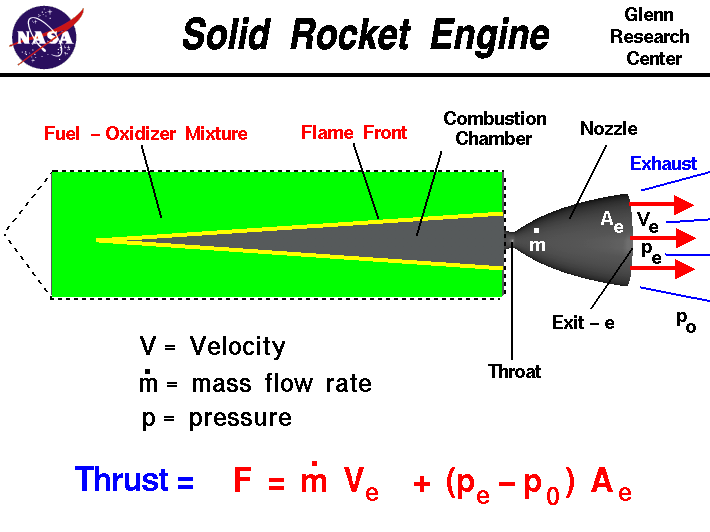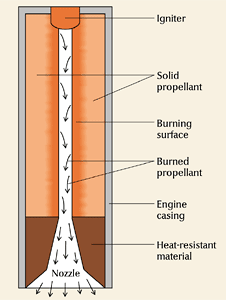|
TYPES OF PROPULSION SYSTEM Missile propulsion will be mainly of the following two types:
The air breathing rocket engines use the surrounding medium of' air for the support of their oxidiser. Thus they can be used only within the Earth's atmosphere whereas in the case of non-air breathing engines the rocket engine itself' carries its fuel and oxidiser on board and hence can be used in space above the Earth’s atmosphere also and is thus independent of the air medium. Depending on the physical state of matter of the propellant used, the rocket propulsion system is designated as a solid rocket motor, a liquid propulsion system or a hybrid propulsion system. Solid Rocket Motor (SRM) In a solid propellant rocket, the propellant to be burnt is contained within the combustion chamber or case. The propellant charge or the grain contains the chemical elements for complete burning. Once ignited, it burns at a designed rate till the propellant is completely consumed. Solid rockets are relatively simple as compared to the other systems. Following are some of the main components of a solid rocket motor.
[The fuel and oxidizer are mixed together into a solid propellant which is packed into a solid cylinder. A hole through the cylinder serves as a combustion chamber. When the mixture is ignited, combustion takes place on the surface of the propellant. A flame front is generated which burns into the mixture. The combustion produces great amounts of exhaust gas at high temperature and pressure. The amount of exhaust gas that is produced depends on the area of the flame front and engine designers use a variety of hole shapes to control the change in thrust for a particular engine. The hot exhaust gas is passed through a nozzle which accelerates the flow. Thrust is then produced according to Newton's third law of motion.] Casing In all solid rocket motors, the casing is a pressure vessel designed and fabricated to withstand up to certain internal pressures. It can be made of a composite material such as fiber reinforced plastic (FRP). Such a casing has low weight and high strength. Casings are also made of metallic alloys. For applications in smaller rockets, titanium alloys and aluminum alloys are used and for bigger rockets nickel alloy steels are used. They are fabricated to give cylindrical shells with ends flared for joints. Complex welding and heat treatment fixtures and processes have been specially evolved for specific casing. The casings are subjected to a number of quality assurance tests for strength, toughness, soundness of weld and hydraulic pressure. The casings are provided with thermal insulation on their inner surface to protect them from hot gases. The casing has provisions for end covers, nozzle and handling, etc. Propellant grain Solid propellants have fuel and oxidizer mixed together in a suitable proportion. Finished propellant body called grain has rigid shape and form as per design. This shape is obtained by casting or extrusion under pressure. On composition basis there are two types of propellants. Homogeneous They are so called because in these oxidizer and fuel are at molecular level. Homogenous propellants are single double or triple bases depending on the number of primary ingredients. Famous example being 'double base' type which is a mixture of nitrocellulose and nitroglycerine in a certain proportion. They are gelled into a semi-rigid body and extruded. They have a fairly long shelf life of more than twelve years. Heterogeneous In this, as the name suggests, the oxidizer and fuel are mixed mechanically in a mixer. They are also called composite propellants. Oxidizers are inorganic crystalline salts like perchlorates or nitrates of sodium, potassium or ammonia, while the fuel, which also acts as binder, is an organic resin. Famous resins used belong to the polybutadiene family, like PBAN-Polybutadiene Anyiic Nitrile; HTPB-Hydroxy Terminated Poly Butadiene; CTPB-Carboxy Terminated Poly Butadiene; etc. HTPB has become the single most widely used resin. In addition, fine metallic powders (aluminum) are also added to increase the energetic quality of the composite propellants along with small quantities of catalysts for various properties. Homogeneous propellants (double base) give specific impulse of about 220 seconds maximum, while composite propellants give 260 seconds and have higher densities but have smaller shelf life. In longer range missiles only composite propellants are used while in smaller tactical missiles, double base propellants are used. Most of the current ballistic missiles are based on solid propellants because they are storable and ready for use and minimal logistic support is needed. Propellant grains may vary in size depending on application. For example, the smallest grain for an anti-tank missile may be only a few kilograms while the largest is 125 tones used in space shuttle boosters where two solid boosters are used. Igniter Igniter is the device that helps to start the burning of the main propellant grain of the rocket motor. Its function is for short interval (0.1-2 seconds depending upon size) only but vital. 'The igniter for small motors will be a few grams of grains while it will be a few hundred kilograms for large boosters. The initiation is done using electrical power by heating a resistance wire and initiating a primary composition. Adequate safety provisions are made through electromechanical devices to prevent accidental initiation. Nozzle [The amount of thrust produced by the rocket depends on the design of the nozzle. The smallest cross-sectional area of the nozzle is called the throat of the nozzle. The hot exhaust flow is choked at the throat, which means that the Mach numberis equal to 1.0 ] The nozzle is the component through which the hot gaseous mass in the motor case is expelled out. This has to be designed to withstand high temperatures and flow of gases at high velocities. The dimensions of the nozzle are critical for the performance and efficiency of the rocket motor. Nozzles are also used for producing control force for the missile. Such a technique is called Thrust Vector Control. It is done by deflecting the flow out of the nozzle or by gimballing of a portion of the nozzle. This nozzle gimballing requires flexible bearing nozzle. (In a gimbaled thrust system the nozzle of the rocket can be swiveled from side to side). References
DRDL Wikipedia GRC.nasa,gov.in Leave a Reply. |
AuthorPalash Choudhari Archives
June 2021
Categories
All
|



 RSS Feed
RSS Feed
